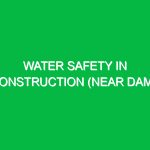Wind and Weather Safety for Construction Sites
Wind and Weather Safety for Construction Sites is a crucial aspect of Health, Safety, and Environment (HSE) management. As construction projects often take place outdoors, they are susceptible to various weather conditions, including high winds, rain, snow, and extreme temperatures. Understanding the implications of these weather conditions and implementing appropriate safety measures can help prevent accidents and injuries, ensuring the well-being of workers and the integrity of the projects being undertaken. This article explores the hazards associated with wind and weather, outlines safety precautions, and discusses relevant regulations that govern this area of safety.
Understanding the Hazards of Wind and Weather
The construction industry faces numerous hazards due to fluctuating weather conditions. Workers must contend with risks that can change rapidly, often without warning. Each weather condition presents unique challenges and hazards that can impact safety on construction sites.
High Winds
High winds can pose significant dangers on construction sites. They can lead to the following hazards:
- Falling Objects: Tools, equipment, and materials can become airborne, posing a risk to workers below. Falling objects can cause severe injuries or even fatalities.
- Structural Instability: Incomplete structures, scaffolding, and temporary supports may not withstand strong winds, leading to collapses.
- Vehicle Hazards: Wind can affect the stability of vehicles and construction equipment, increasing the risk of accidents.
Rain and Wet Conditions
Wet weather can create several hazards that affect worker safety:
- Slips and Falls: Wet surfaces can be slippery, increasing the likelihood of falls among workers.
- Equipment Malfunction: Rain can affect the operation of machinery, leading to potential accidents.
- Flooding: Heavy rain can result in localized flooding, which can hinder access to the site and create additional hazards.
Extreme Temperatures
Extreme temperatures, whether hot or cold, pose risks to construction workers:
- Heat Stress: In high temperatures, workers may experience heat exhaustion or heat stroke, which can be life-threatening.
- Cold Stress: Cold weather can lead to hypothermia and frostbite, especially for workers exposed to wind chill.
Safety Precautions for Wind and Weather Conditions
To ensure Wind and Weather Safety for Construction Sites, it is essential to implement various safety precautions. Here are some best practices that can significantly reduce risks associated with different weather conditions:
Preparation and Planning
Proper preparation is vital for mitigating weather-related hazards:
- Weather Monitoring: Use reliable weather forecasting services to stay informed about impending weather changes. Regularly check weather updates, especially before starting work.
- Develop a Weather Response Plan: Create a response plan that outlines how the site will respond to various weather conditions. Include evacuation procedures, communication methods, and designated safe areas.
- Training: Provide training for workers on how to recognize weather hazards and implement safety measures effectively. Ensure everyone understands the importance of reporting unsafe conditions.
High Winds Safety Measures
When high winds are forecasted, take the following precautions:
- Secure Loose Materials: Ensure all tools, equipment, and materials are secured to prevent them from becoming projectiles.
- Stabilize Structures: Use appropriate bracing and supports for incomplete structures and scaffolding to enhance stability.
- Limit Work Activities: Consider halting work activities, especially at heights, when winds exceed safe operating limits.
Rain and Wet Conditions Safety Measures
In the event of rain, implement these safety measures:
- Use Non-Slip Footwear: Ensure workers wear appropriate footwear with good traction to minimize slip hazards.
- Inspect and Maintain Equipment: Regularly check machinery and tools to ensure they function correctly in wet conditions. Take steps to protect electrical equipment from moisture.
- Manage Water Accumulation: Implement drainage solutions to prevent water pooling on the site and reduce the risk of flooding.
Extreme Temperatures Safety Measures
To address extreme temperatures, follow these guidelines:
- Hydration and Rest Breaks: In hot weather, encourage workers to drink plenty of water and take regular breaks in shaded or cool areas.
- Appropriate Clothing: Provide workers with suitable clothing for extreme weather conditions, including insulated gear for cold weather and breathable fabrics for hot weather.
- Monitor Workers: Assign supervisors to monitor workers for signs of heat stress or cold-related illnesses, and take immediate action if symptoms arise.
Regulations and Standards for Wind and Weather Safety
Several regulations and standards guide Wind and Weather Safety for Construction Sites. Compliance with these regulations is essential for ensuring worker safety and avoiding legal liabilities:
Occupational Safety and Health Administration (OSHA)
OSHA sets forth regulations regarding safety on construction sites, including guidelines for addressing various weather-related hazards. Employers must ensure that their worksite is free from recognized hazards that could cause death or serious physical harm. Specific standards may apply to fall protection, scaffolding, and the use of personal protective equipment (PPE).
American National Standards Institute (ANSI)
ANSI provides various standards related to safety equipment and practices in construction. These standards help ensure that workers have the appropriate tools and PPE to protect them from weather-related hazards.
National Fire Protection Association (NFPA)
The NFPA offers guidance on maintaining safe working conditions, particularly in relation to emergency procedures and equipment safety. Adhering to these standards can help mitigate risks associated with extreme weather events.
Conclusion
Wind and Weather Safety for Construction Sites is a vital part of protecting the health and safety of workers. Understanding the potential hazards associated with different weather conditions enables construction managers and workers to take proactive measures to ensure safety. By implementing appropriate safety precautions, maintaining compliance with regulations, and fostering a culture of safety awareness, construction sites can minimize the risks posed by wind and weather. Ultimately, prioritizing weather safety not only protects workers but also enhances overall project efficiency and success.


